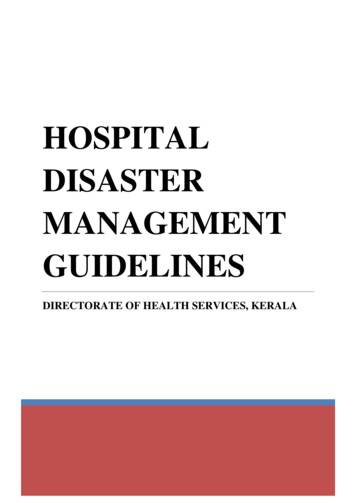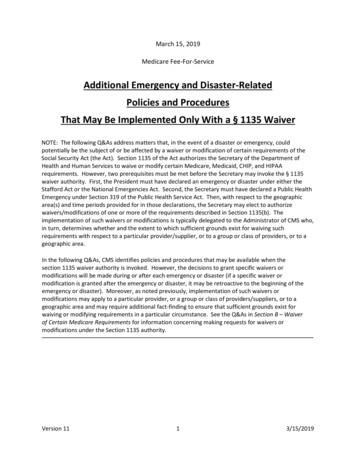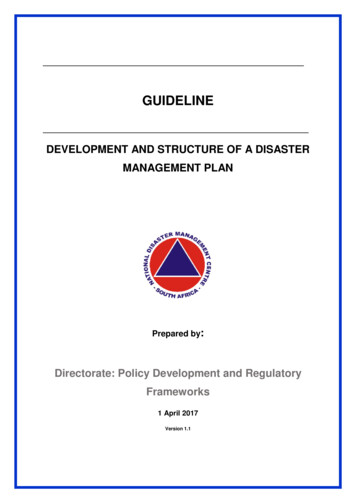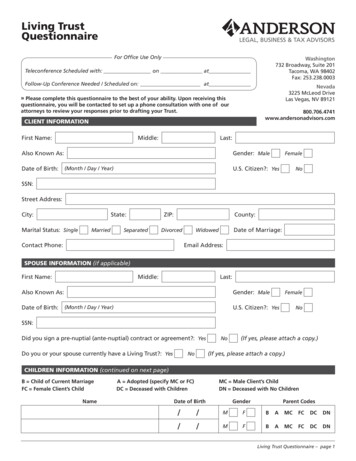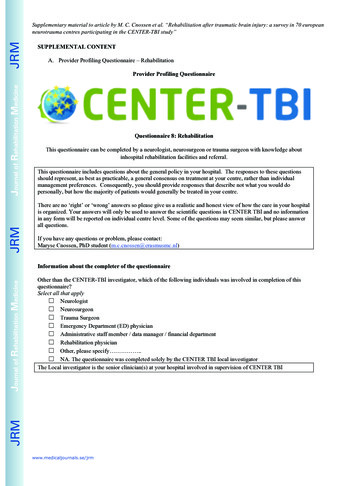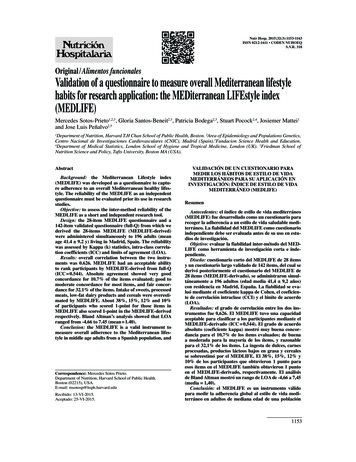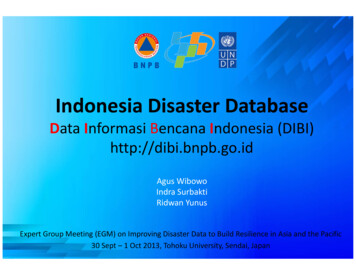
Transcription
Disaster ManagementQuestionnairePrepared by: UNDP / BCPRAugust 2002 (format)Questionnaire completed: October 21 2002Organisation: RK Agency for EmergencyAddress: 91 Ablai Khan Ave., Almaty 480091, KazakhstanCountry: KazakhstanTelephone: (3272) 919390, 695403, 695806, 696813, Fax:696411E-mail: chs@emer.kz, http: ns.emer.kz
ForwardUnited Nations Development Programme in collaboration with the Bureau of Crisis Prevention and Recovery is currently assessing the disaster management capacities of thecountries in the sub-region of South-west and Central Asia (Afghanistan, Azerbaijan,Iran, Kazakhstan, Kyrgyzstan, Pakistan, Tajikistan, Turkey, Turkmenistan and Uzbekistan). The purpose of this study is to determine opportunities to strengthen national andregional disaster management capacities through a sub-regional initiative. The initiativewould potentially help to share knowledge and information within the region, promoteinter/country relations, assist in developing national and regional programmes and wouldfacilitate training and education in all areas of disaster management. The initiative wouldalso have a website which would incorporate an on-line library and databases of disasterhistory in the region, list of disaster management organisations and experts in the region,best practices and disaster management structure, strategies and policies of the countriesof the region.This questionnaire guides the process of data collection from key organisations of thecountries such government departments, Red Crescents, NGOs, universities and researchinstitutes. The answers to questions will serve to create a national report on disaster management capacities of the country. Certain questions are specific and can only be answered by the corresponding organisations. Other questions can be replied to by all organisations. Please read all questions, and answer the ones pertinent to your organisation.The questionnaire also comprises two excel files:Chronicle and description of past disastersLevel of risk and vulnerability in districtsIf you are aware of other relevant information such as existing databases, please append asoft copy (if possible) to this questionnaire.Thank you.Страна:2
Table of contents1.DISASTER PROFILE. 4HAZARDS . 4VULNERABILITY/ COMMUNITIES . 62.NATIONAL POLICIES, PLANS AND PROJECTS . 8POLICIES . 8PROJECTS/ PROGRAMMES . 9TRAININGS . 93.GOVERNMENT STRUCTURES:. 104.NON-GOVERNMENT STRUCTURE . ERROR! BOOKMARK NOT DEFINED.RED CROSS/ CRESCENT OR EQUIVALENT SOCIETY. 155.UN COUNTRY OFFICE . 176.MATERIAL AND HUMAN RESOURCES. 17EARLY WARNING SYSTEMS . 17RELIEF RESOURCES. 18COMMUNICATIONS. 207.FUNDING. 218.INTERNATIONAL AND NATIONAL ASSISTANCE ORGANIZATIONS. 229.LINKS OUTSIDE THE COUNTRY . 2310.Страна:STRENGTHS, GAPS, OUTSTANDING NEEDS & REQUIREMENTS . 243
1.Disaster profileHazardsComplete the attached database regarding natural disasters, industrialaccidents and population displacements, which occurred between theyears 1990 to 2002.What are the impacts of most damaging hazards occurring in the country, on communities, infrastructure, environment etc.Varied natural conditions in Kazakhstan determine its considerable vulnerability tohazardous natural emergencies such as earthquake, mudflow, landslides, landfalls, riverflood, draught, temperature drops in spring and autumn, flood in the coastal area of theCaspian Sea, forest and steppe fires, outbreaks of hazardous infections etc.High urban extension and industrialisation in Kazakhstan determine also occurrences of fires and explosions in industry and household activities including those withemission of toxic substances, and transport and industrial accidents.Hazardous natural and man-caused occurrences often induce natural and mancaused catastrophic emergencies.A special concern arises in relation with man-caused emergencies, primarily thosewhich may occur in hazardous industrial objects and household explosions, transport andindustrial accidents which cause high damage to the country.High probability of man-caused emergencies exists when operating hazardousobjects of key industries in Kazakhstan.97 people and 78 of them died as a result of sudden explosion of methane in 1978in Sokurskaya mine (Karaganda coal basin).The world classifier of natural calamities and man-caused disasters reports of theoil and gas blow-out in Tengiz in 1986 which required 400 days for its liquidation.High intensity of oil operations in the sea in inland water bodies of Kazakhstan,deterioration of technical conditions of wells flooded by the Caspian Sea and increasedoil transportation by sea aggravate the risk of large-scale disasters of transboundary effect.The most disastrous consequences of transboundary impact may happen if noimmediate measures are taken against environmental threats in Pavlodar Chemical PlantOJSC with about 1000 tons of mercury stored under the building 2 meters deep. So,populated areas of Kazakhstan and Russia adjacent to the Irtysh and Ob Rivers are exposed to danger.Hazardous industrial objects of mining complex are the source of high industrialrisk. Over 60% total number of deadly injures in mining enterprises happen in the oremining complex. This year coal mining objects have reported 6 fatal cases and 8 heavyinjury cases.A real threat of disaster with a large number of victims and considerable materialdamage exists when gas is used in houses and municipal-domestic objects in Kazakhstan.45 explosions have been registered in houses in 2001 with 72 victims (13 of those haveСтрана:4
died). In 2002 22 people have suffered from gas explosions in the housing sector and 2of them got lethal injuries. One of the main reasons of disasters is a lack of control oversafe use of gas by people which was lost in early 90th in Kazakhstan.Unstable situation is seen in relation with emergencies associated with hazardousinfections and other infectious diseases. Many cases of plague and cholera have been recorded. Regular cases are reported of tularaemia, brucellosis, anthrax, Crimean-Congohemorrhagic fever and typhoid fever. An adverse situation is seen for tuberculosis, hepatitis, HIV and venereal diseases.Every year direct damage from emergency in the country makes 2.2 – 3.5 billiontenge. By expert assessment indirect damage is estimated to be 15-20 billion tenge anddamage from lethal cases and medical treatment of victims makes 3 billion tenge. Thetotal estimated amount may reach 25 billion tenge per year.Since 1994 about 40 thousand people died and over 250 thousand people sufferedfrom emergencies in Kazakhstan and total direct damage (apart from indirect damage)was over 0.6 billion USD. These data do not even reflect potential consequences ofglobal disasters which are not predictable.How are risks identified and expressed? – reports, database, maps, �хHazardous meteorologyххForest and steppe ersand catastrophesWhat organisations keep records of past disasters?Earthquakes: Seismology Institute of the Ministry of Education and ScienceСтрана:5
Floods: Kazgidromet Republican State Enterprise of the Ministry of Environmental ProtectionDrought: Kazgidromet Republican State Enterprise of the Ministry of Environmental ProtectionLandslides/ avalanche: Kazgidromet Republican State Enterprise of the Ministry of Environmental Protection, Institutes of Geology and Geography of theMinistry of Education and ScienceEpidemics: Ministry of HealthOthers: (including all natural and man-induced disasters) RK Agency ofEmergency.Vulnerability/ CommunitiesComplete the attached database regarding the type and level of disasterrisk and vulnerability in the districts of your country.Are villages (rural areas) prone to disaster identified?No any special comprehensive research to assess the risk and area vulnerability inKazakhstan. Preliminary oblast-level large-scale and country-level small-scale maps areavailable for specific risks: seismic hazard, mudflow hazard, flood zone maps, spread ofhazardous infections.The list of possible natural calamities are available for any populated area in Kazakhstan.What major historic infrastructures are likely to be affected by futuredisasters? What actions have been taken to reduce the risk?In Kazakhstan state management in the field of protection of people and territoriesfrom natural calamities, disasters, catastrophes and the associated emergencies is implemented by the State Emergency System (SES) established by Decree of the Cabinet ofMinisters of Kazakh SSR ref. 935 dated June 25, 1991.SES operations are governed by RK Constitution, Laws of Kazakhstan “On Natural and Man-Induced Emergencies”, “On Civil Defence”, “On Rescue Services andStatus of Rescuers”, “On Fire Safety”, Decree of RK Government “On the State Emer-Страна:6
gency System” dated August 28, 1997 ref. 1298 and other legal and normative documents.SES is established to prevent and liquidate natural and man-induced emergenciesin peace and war time.Key goals of SES are enlisted below:- implement a unified national policy in the field of emergency liquidation and prevention, protection of human life and health, protection of material and culturalvalues and environment;- develop the system of economic and legal measures to ensure protection of people, technical and environmental safety;- develop national, industry-based, regional and scientific-technical programs focused on emergency prevention, protection of human being and environment, sustainable operation of economic and social objects in the event of emergency, disaster, natural calamity, epidemic, epizooty, epiphytoty;- readiness of control points and bodies, communications and warning systems,means and efforts of SES in order to ensure prompt emergency response, rescueactivities and other urgent liquidation operations;- forecast and assessment of social-economic consequences;- primary livelihood of affected people;- emergency training for people, training and professional upgrade of SES personnel;- international co-operation in the field of emergency prevention and liquidation,assistance to foreign countries to liquidate the consequences of disasters, catastrophes and natural calamities.Agencies included in SES composition are enlisted as follows: RK Agency of Emergency (EA) which ensures the overall SES management, andits territorial branches and subdivisions; Management bodies, day-to-day management bodies (monitor-control services) ofcentral executive authorities and national organisations competent in emergencyprevention and liquidation; In-service rescue divisions of central and local executive authorities and organisations, territorial and object-based emergency and civil defence units and services;Forest protection services, disaster medicine services, unified air rescue services ofKazakhstan, environmental monitoring and control services (impact of potentially hazardous objects) of central executive bodies and organisations of Kazakhstan, RepublicanSeismic Observation and Forecast System.In compliance with Resolution of RK Government, EA shall ensure inter-sector coordination, fulfil special licensing function related to natural and man-caused emergencyprevention and liquidation, bear responsibility for RK Civil Defence operations and firesecurity, supervise safe industrial and mining operations.Co-ordination of central and local executive authorities and organisations:On the national level: RK Agency on Emergency, Interdepartmental EmergencyCommission, Republican Epidemic Commission, Interdepartmental Blasting WorkCouncil, Emergency Commission within central executive authorities;Страна:7
On the local level: RK Agency on Emergency through its territorial branches, emergency commissions of local executive authorities and organisations based in the relevantjurisdictions.SES is continuously developing and its enhancement will contribute to improvements.Measures to reduce the risk of emergency are taken through specific, annual, midterm and long-term national development programs approved by the authorised bodies.Are there communities that organise themselves to monitor potentialdisasters? (e.g. monitoring river levels)No information within EA available.What is the level of awareness of disaster risk factors at the communitylevel?Community awareness of risk factors is ensured under the Laws of Kazakhstan«On Natural and Man-caused Emergencies», «On State Secrets» which prohibits secrecyof any information in the field of emergency, and other normative and legal documents ofKazakhstan.How ready are communities to understand official warnings and react?Communities are supervised to timely implement the approved emergency response and warning plans.What percentages of vulnerable areas have evacuation plans/maps?All !!!!!2. National policies, plans and projectsPoliciesIs there a national disaster management policy, act or related legislation? Specify.See the heading What major historic infrastructures are likely to be affected byfuture disasters? What actions have been taken to reduce the risk? (above)Are there national disaster management plans and procedures? Specify.To prepare efforts and emergency response measures, to co-ordinate the activitiesof central and local executive authorities in occurrence and liquidation of emergency theAgency has developed relevant National plans including civil defence plans of Kazakhstan for peace and war time, earthquake response plans, winter emergency plans, floodСтрана:8
plans, plans of using chemical, radioactive and biological toxic substances, refugee plansetc.In 2000 Emergency Agency in co-operation with UNDP have prepared the Plan ofKazakhstan’s preparedness to natural calamities within the project of RK Government.In 2002 within the project of Capacity building for Kazakhstan’s emergency preparedness the proposals have been given to develop key activities in the field of emergency:development of emergency information management GIS-based system for Almaty Cityfor the event of disastrous earthquake; codification of civil defence and emergency laws;establishment of national information-analytical centre etc.The relevant plans have been developed on the oblast and local level, in the ministries, departments, enterprises and organisations.The above plans identify functions of ministries, departments, enterprises and organisations as well as local authorities to liquidate emergency situation; those plans describe the efforts and means employed, procedure of communications and information.In order to ensure practical testing of the plans as above as well as their adjustmentand development test every year the Agency of Emergency organise countrywide training «WINTER», «SPRING», «FIRE», «EARTH», manoeuvre training «NEPTUN»,«KAZSPAS». Local authorities, Civil Defence and Emergency services from all oblastsof Kazakhstan take part in such training. Preparedness reports are made to the Government on the basis of the results of such courses. Seismic training are organised in Almatyand earthquake areas. Destructive earthquake response training courses have also beenorganised in Kazakhstan. In addition to such large-scale training, command-and-stafftraining exercises are organised with involvement of experts and managerial staff of central and local executive authorities.Projects/ ProgrammesList the past, current and pipeline projects in disaster management sector, specifying the owners (UN, the World Bank, Government ) andthe executors of the projects (Provincial Gov. NGOs ):See the previous Section passage 2.Are there any disaster awareness and public information projects orprogrammes being undertaken in the country?Yes. The work is carried out within mass media plans annually approved by AE.TrainingWhat is the disaster management training strategy and/or plan of thecountry with regards to disaster management?To ensure prospective planning for emergency prevention and liquidation, theConcept Paper and the draft Republican Program of State Emergency Prevention andLiquidation for 2003-2005 (hereinafter referred to as the Program) have been elaboratedin 2002. The Program is focused on the following issues: normative and legal base, instiСтрана:9
tutional development of SES and EA, activation and improvement of central and localauthorities in the field of emergency, logistical support of SES, SES emergency planning, research development in the field of emergency and civil defence, personnel training and retraining, international co-operation development, social protection of rescuersand people involved in emergency prevention and liquidation activities.Has disaster management training been undertaken in the country? Isso what which organisation (s)? What form of training has been utilisedand who has been the audience?Type of TrainingFull-time attendanceAudienceAdministration staffTrainerRepublicanprofessional training coursesin the field of civil defence and emergencyFull-time attendanceCommanders of civil de- Trainingfenceandemergency sWhere are the training centres located?Location of training centres: Central training centre in Almaty- Republicanprofessional training courses in the field of civil defence and emergency; oblastlevel centres of emergency departments – in oblast centresIs there training at the community level?Emergency training activities for population using mass media (newspapers, TV coverage)3. Government structures:What is the structure/ organigram for disaster management in the country? What is the number of personnel in each organisation/ agency?Страна:10
See the heading What major historic infrastructures are likely to be affected byfuture disasters? What actions have been taken to reduce the risk? (above) and Annex1.List all of governmental organisations related to disaster nstructionEA and ttodittodittodittodittodittocentral strictIs there a national disaster management office/ ministry or a nationaldisaster response mechanism? SpecifySee the heading What major historic infrastructures are likely to beaffected by future disasters? What actions have been taken to reduce the risk? (above).Is the office in charge of disaster management a military force/ formation?No.What are the criteria for recruitment in the offices of disaster management? (Military ranks )The laws of Kazakhstan «On State Service» and «On the Universal Military Obligation and Military Service».Is there transfer/ rotation of staff between districts and regions?Страна:11
Yes.What are the functions of the provincial and local authorities in disastermanagement? (e.g. Evacuation)Authorities of local executive bodies are provided by the Law of Kazakhstan «OnNatural and Man-caused Emergency» and other normative and legal documents.Which governmental entity has the mandate of assisting during a disaster?ArmyFire fightersPoliceNormally SES (including the above-mentioned forces)How are various sectors such as (agriculture, health, infrastructure,education, Water resources, Interior) engaged in risk management issues?Within SES systemHow is the ministry of health organised for preparednessIn accordance with the norms provided by SES.What ministry is in charge of maintaining law and order during disaster?Ministry if InteriorWhat entity co-ordinates the actions of all of the ministries?RK Agency on EmergencyIs there a published overview to ensure a common understanding of theprecise roles of and inter-relationships between different bodies (ministries, NGOs, Offices, )The procedure is established by the relevant resolution of RK Government. Nongovernmental entities.Identify NGOs, international organisations, etc working in any aspect ofdisaster management:National NGOs:NameСтрана:Area of WorkNo. of PersonnelLocation of Work12
RKRedCross Mitigation,and Crescent So- sponse,cietyre- About 100 peopleCountrywidehumani-tarian aid for affected peopleInternational NGOs/ Organisations:NameNationalityArea of WorkLocation of WorkUniversities and Geo-Physical Institutions:NameСтрана:Area of WorkNo. of PersonnelLocation of Work13
Foremergencyprevention measuresuniversitiesare involved incertain activitiesInstitutes of geog- Researchraphy,geology, forecast of naturalseismology, Kaz- andgidrometandandotherman-causedRSE hazardAEsubdivisionsOtherNameСтрана:Area of WorkNo. of PersonnelLocation of Work14
Identify Financial and regulatory instrumentsInsurance sector (level of engagement)No engagementBuilding codes / bylawsModern building guidelines have been developed, approved and applied.What is the nature of liaison between governmental disaster management entities with the academic of the national disaster management institutions?Through SESWhat is the framework of co-operation between the ministry in chargeof disaster management, the Red Crescent and the NGOs?Under Co-operation Agreements (the scale of co-operation is small) with RKRed Crescent/ Red Cross or other similar organisationsRed Cross/ Crescent or equivalent SocietyYes.What is the structure/ organigram of the Red Cross/ Crescent?National RC&RC includes Central Committee and oblast-level (14), citylevel and district subdivisionsWhat are the functions of the Red Crescent?Establish reserve stocksIdentify vulnerable groups in the populationProvide emergency humanitarian assistance to injured/ affectedpeoplecollaboration with the government in creating rapid-response teamsСтрана:15
All the above-stated functionsHow many branches of the Red Crescent are there? Where are they located?Headquarter is located in Almaty, 14 oblast-level committees, 2 citycommittees (Almaty and Astana) and local subdivisions.Is the Red Crescent responsible for operation in any other countries?No.How are the RC volunteers trained?Volunteers are engaged through youth movement; workshops, trainingcourses etc.Refer to section 6 for Relief Inventory of RC.Страна:16
4.UN Country OfficeList of UN offices in the country:Is there an effective UN Disaster Management Team?How is co-ordination between different agencies done for disaster mitigation, relief and reconstruction?5.Material and human resourcesIs there an information management system for disaster responsemanagement? What organisation manages the system?AEEarly Warning SystemsWhat early warning systems are in place? Where?Flood, mudflow, hazardous meteorological events: Kazgidromet RSESeismic hazard: Institute of SeismologyDrought: Kazgidromet RSEWhat organisation is responsible for disaster warning? (e.g. flood)?Страна:17
AE and its territorial entities based on the forecast of related organisations.Relief ResourcesIdentify human resources available for disaster management in thecountryRed Cres-GovernmentcentSearch & Rescue Person-Nodata ROSO andnel (FTE)available5 re-gional units, rescueunits of regional 051Rescue TeamsRelief volunteers---«----No data availableEmergency doctors----«---DisasterMedicineCentreDisaster management----«---No data availableLogistics officers-----«--No data availableMeteorology experts-----«--Approved staffHeavy machinery opera------«--No data availabletrainers:tors:Страна:18
Identify materials available for disaster management in the country (fordifferent organisations : RC, WFP,)Red CrescentImmediaterelief No approvedfor x personsImmediatenormsrelief ----«---of x hoursReady-to-eat food----«---# of tents----«---# of cars----«---# of Bulldozers---«---# of Excavators---«---# of Trucks----«--# of Helicopters---«---Sufficient Fuel---«---Sufficientspare ---«--partsReserves for emergency prevention and liquidation are based in various departments and organisations. Data of availability and item identification aresecret.Warehousing facilitiesRed Crescent# of Warehouses4Location and SizeAlmatyWFOKaragandaUralskСтрана:19
SemipalatinskWhat ministry is responsible to arrange transport to meet emergencies? (e.g.transportation to safe areas)Civil Defence and Emergency Transport Services established in the Ministry ofTransport and Communications; oblast-level transport services.What are the capacities to respond to chemical/ industrial accidents?Organisations which use hazardous chemicals have the appropriate means as provided by emergency liquidation plans.CommunicationsCommunicationsHow are the warnings transmitted to officials and to the population? (Channelsof dissemination) CommunicationsHow are the warnings transmitted to officials and to the population?(Channels of dissemination)Страна:20
National warning system is used to warn government authorities and population. Clarified information is disseminated by TV and radio.What are the means of communications? (e.g. HF radio, normal phonelines). How dependable are these communication means?Radio and telephone channels.Is public radio/T.V. used to broadcast disaster warnings?Radio and telephone channels.Do all high risk areas have a HF radio?Observation point located in mudflow dangerous areas are equipped with communications facilities to be able to provide warning of possible dangerous occurrences.Are there radios in electrical sub-stations, water pumping stations,meteorology and hydrology posts, etc Available in all points. All points are being equipped by radio stations.Can all frequencies turn into a common UN security channel in case of asecurity alert (common disaster frequency)?No information available. No any activities carried out.Is there co-ordination between radio frequencies of different offices/organisations during disaster?Radio frequencies are available for emergency occurrences.6.FundingWhat has been the impact of disaster in the country during the past 5years? (GDP, development)1-2% GDP per yearAverage budget of the government per year allocated 0,5-1,0% GDPСтрана:21
Average cost of disaster to the government per year?ReliefReconstructionSee aboveIs the national disaster office and/ or programme fully funded by thegovernment? What is its budget?No. About 50-70 million.What are the sources of funding for emergency responses and relief programmes?Financial reserves of local executive authorities, related organisations and GOK.What role do international financial (lending) institutions play?Allocation of 300 000 to develop Natural Calamity Preparedness Plan of Kazakhstan.7.International and national assistance organisationsWhat are the existing international and regional operational supports?Consulting and technical assistance in seismic hazard forecast and emergency prevention (Japan, China, Russia).Have national organisations been established to bring together keystakeholders of disaster management? E.g. REACT, what are theirfunctionsNoWhat entity co-ordinates international response?Ministry of External AffairsDo programmes and procedures exist for mutual assistance betweenneighbouring jurisdictions?A package of relevant agreements between CIS.Страна:22
How can the collaboration between various players be enhanced?On the basis of increased humanitarian aid from developed countries.What has been the country’s experience with the provision and receiptof international assistance?Kazakhstan provides humanitarian aid to Mongolia, Tajikistan, Uzbekistan, Kyrgyzstan, Yakutia, Turkey, Afghanistan, Czech Republic, Poland,Slovakia, Azerbaijan etc. Kazakhstan received technical humanitarian aidfrom USA, Japan and China.8. Links outside the countryIdentify any organisations outside the country that Government and/orNGOs have links with in terms of disaster management; Determine thenature of those links?The country has links with CIS within the relevant agreements, links withNATO within Partnership for Peace Program, Asian Disaster Centre, AsianDisaster Preparedness Centre, International Civil Defence Organisation, Interstate Emergency Council, International RC&RC Federation etc. Friendlyrelations.Are there any relevant international/ regional agreements relating toany aspect of disaster management:Watershed / flood management protocols:The protocols are signed with neighbouring countries: Russia, China, Kyrgyzstan, Uzbekistan, TurkmenistanCustoms agreementsRK Customs Code--------«---------Transit of relief materials to other countriesRoad, railway, air -------«-----------Страна:23
How can collaboration between the government and
The answers to questions will serve to create a national report on disaster man-agement capacities of the country. Certain questions are specific and can only be an-swered by the corresponding organisations. Other questions can be replied to by all or-ganisations. Please read all questions, and answer the ones pertinent to your organisation.
